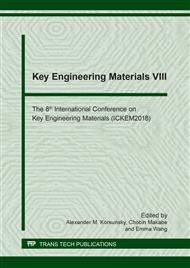[1]
A. Safari, R. Saidur, F.A. Sulaiman, Yan Xu, Joe Dong, A review on supercooling of Phase Change Materials in thermal energy storage systems, Renew. Sust. Energ. Rev. 70 (2017) 905–919.
DOI: 10.1016/j.rser.2016.11.272
Google Scholar
[2]
B. Parsons, Design guide for cool thermal storage, ASHRAE Inc., Atlanta, (1993).
Google Scholar
[3]
Y. Liu, X. Li, P. Hu, G. Hu, Study on the supercooling degree and nucleation behavior of water-based graphene oxide nanofluids PCM, Int. J. Refrig. 50 (2015) 80–86.
DOI: 10.1016/j.ijrefrig.2014.10.019
Google Scholar
[4]
Z. Kang, R. Wang, X. Zhou, G. Feng, Research status of ice-storage air-conditioning system, Procedia Eng. 205 (2017) 1741–1747.
DOI: 10.1016/j.proeng.2017.10.020
Google Scholar
[5]
R.P. Sear, Nucleation: theory and applications to protein solutions and colloidal suspensions, J. Phys.-Condes. Matter 19 (2007) 033101(28 pages).
DOI: 10.1088/0953-8984/19/3/033101
Google Scholar
[6]
R.P. Sear, Quantitative studies of crystal nucleation at constant supersaturation: Experimental data and models, Crystengcomm 16 (29) (2014) 6506–6522.
DOI: 10.1039/c4ce00344f
Google Scholar
[7]
X.J. Wang, X.F. Li, Y.H. Xu, D.S. Zhu, Thermal energy storage characteristics of Cu-H2O nanofluids, Energy 78 (2014) 212-217.
DOI: 10.1016/j.energy.2014.10.005
Google Scholar
[8]
S. Wu, D. Zhu, X. Li, H. Li, J. Lei, Thermal energy storage behavior of Al2O3-H2O nanofluids, Thermochim. Acta 483(1) (2009) 73- 77.
DOI: 10.1016/j.tca.2008.11.006
Google Scholar
[9]
T.P. Teng, Thermal conductivity and phase-change properties of aqueous alumina nanofluid, Energy Conv. Manag. 67 (2013) 369–375.
DOI: 10.1016/j.enconman.2012.12.004
Google Scholar
[10]
A.A. Altohamy, M.F. Abd Rabbo, R.Y. Sakr, A.A.A. Attia, Effect of water based Al2O3 nanoparticle PCM on cool storage performance, Appl. Therm. Eng. 84 (2015) 331-338.
DOI: 10.1016/j.applthermaleng.2015.03.066
Google Scholar
[11]
L. Jia, L. Peng, Y. Chen, S. Mo, X. Li, Improving the supercooling degree of titanium dioxide nanofluids with sodium dodecylsulfate, Appl. Energy 124 (2014) 248–255.
DOI: 10.1016/j.apenergy.2014.03.019
Google Scholar
[12]
L.W. Fan, X.L. Yao, X. Wang, Y.Y. Wu, X.L. Liu, X. Xu, Z.T. Yu, Non-isothermal crystallization of aqueous nanofluids with high aspect-ratio carbon nano-additives for cold thermal energy storage, Appl. Energy 138 (2015) 193–201.
DOI: 10.1016/j.apenergy.2014.10.077
Google Scholar
[13]
Kholmanov, J. Kim, E. Ou, R.S. Ruoff, L. Shi, Continuous carbon nanotube ultrathin graphite hybrid foams for increased thermal conductivity and suppressed subcooling in composite phase change materials, ACS Nano 9 (2015) 11699–11707.
DOI: 10.1021/acsnano.5b02917
Google Scholar
[14]
V. Kumaresan, P. Chandrasekaran, M. Nanda, A.K. Maini, R. Velraj, Role of PCM based nanofluids for energy efficient cool thermal storage system, Int. J. Refrig. 36(6) (2013) 1641-1647.
DOI: 10.1016/j.ijrefrig.2013.04.010
Google Scholar
[15]
A. Zabalegui, D. Lokapur, H. Lee, Nanofluid PCMs for thermal energy storage: Latent heat reduction mechanisms and a numerical study of effective thermal storage performance, Int. J. Heat Mass Transf. 78 (2014) 1145-1154.
DOI: 10.1016/j.ijheatmasstransfer.2014.07.051
Google Scholar
[16]
JCPDS-ICDD. The International Centre for Diffraction Data 2003, PCPDFWIN 2.4.
Google Scholar
[17]
X. Zhang, J. Niu, S. Zhang, J.Y. Wu, PCM in water emulsions: supercooling reduction effects of nano-additives, viscosity effects of surfactants and stability, Adv. Eng. Mater. 17 (2) (2015) 181–188.
DOI: 10.1002/adem.201300575
Google Scholar
[18]
C.A. Sholl, N.H. Fletcher, Decoration criteria for surface steps, Acta Metall. 18 (10) (1970) 1083–1086.
DOI: 10.1016/0001-6160(70)90006-4
Google Scholar


